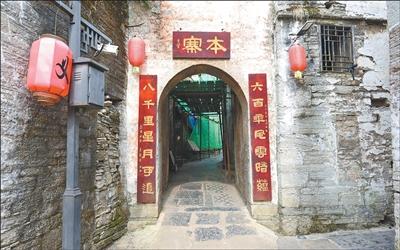




- BRNN
- BRI News
- BRNN News
- Database
Official Documents Polices and Regulations
Inter-government Documents International Cooperation BRI Countries
Business Guide Economic Data BRI Data
Trade
Investment Projects Latest projects
Cases - Content Pool
In recent years, southwest China's Guizhou Province has worked to uphold tradition while embracing innovation, exploring the historical significance, contemporary relevance, and spiritual essence of its Tunpu culture. By deepening the integration of culture and tourism, the province is transforming itself into a vibrant cultural powerhouse.
Tunpu means "fort" in Chinese. The term refers to the complexes of residential buildings in Guizhou villages, built in the style of fortresses to resist enemy attacks in ancient times.
Walking through Benzhai village in Xixiu district of Anshun city feels like stepping back in time, as fortresses and homesteads merge seamlessly into one.

Photo shows a view of Benzhai village, Xixiu district, Anshun city, southwest China's Guizhou Province. (Photo courtesy of the Media Convergence Center of Anshun City)
"Benzhai may look like an ordinary village, but it was actually a military garrison built during the Ming Dynasty (1368-1644)," said Jin Boyi, Party chief of the village.
In the early Ming Dynasty, troops were sent to Guizhou, where they built stone Tunpu residential buildings and cultivated farmland. Their descendants have lived there for generations, preserving their original customs. Thus, the unique Tunpu culture gradually took shape.
Today, thanks to careful preservation efforts, visitors to Benzhai can still admire the exquisite carvings on archways, latticed doors and windows, and other traditional architectural elements.
The village boasts 36 quadrangle courtyards, 27 of which are designated as cultural relics. With support from various parties, Benzhai has invested more than 30 million yuan ($4.22 million) in recent years to restore and maintain its historic architecture.
Guizhou has cataloged its Tunpu cultural assets, documenting the history, customs and traditions of more than 300 Tunpu villages. Work is underway on the province's overall plan for the protection and utilization of Tunpu culture.
According to Jiang Pingping, a member of the Guizhou Tunpu Culture Research Association, Tunpu culture absorbs elements from local ethnic groups, fostering the integration of Central Plains traditions with Guizhou's distinctive ethnic cultures and exemplifying Chinese civilization's unity in diversity.
Huadeng opera and Dixi opera, two forms of traditional Chinese opera, are integral parts of Tunpu culture. From dialect and costumes to cuisine and festivals, and from stone-structured houses to Dixi opera performances, the spiritual values of loyalty, courage, harmony and integration have kept Tunpu culture alive.
In Tianlong Tunpu, located in Anshun's Pingba district, local women dressed in traditional Tunpu attire welcome visitors with bowls of tea.
"More tourists keep coming, and life keeps getting better," said Zhang Alian, who runs an agritainment restaurant in her family residence and earns 120,000 yuan annually from the business.
"Transforming research findings on Tunpu culture into tourism, education, and literary resources is an urgent task," said Qian Liqun, a professor at Peking University.
Jiuzhou ancient town, a cradle of Tunpu culture in Anshun, preserves many buildings from the Ming and Qing dynasties. In recent years, Anshun has completed extensive restoration of old residences and historic streets, while developing innovative tourism offerings.
In the first 10 months of this year, the ancient town received over 2.9 million tourist visits, up 26.3 percent year on year, generating tourism revenue of 170 million yuan, a 52.8 percent increase from the same period last year.
Guizhou has promoted the creative transformation and development of Tunpu culture by integrating it with tourism and technology. The province has incorporated its more than 700 Tunpu settlements into touring routes, leveraging Tunpu villages, Dixi opera performances, traditional costumes, and other cultural and tourism resources to cultivate a thriving cultural tourism industry.

Tel:86-10-65363107, 86-10-65368220, 86-10-65363106